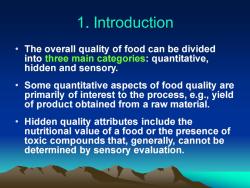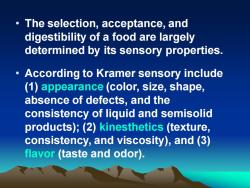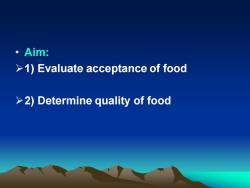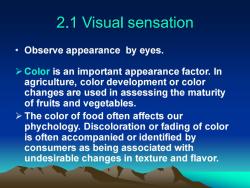河南科技学院:《食品分析》课程教学课件(PPT讲稿)Chapter 3 Sensory test

Chapter 3. Sensory test
Chapter 3. Sensory test

1. Introduction • The overall quality of food can be divided into three main categories: quantitative, hidden and sensory. • Some quantitative aspects of food quality are primarily of interest to the process, e.g., yield of product obtained from a raw material. • Hidden quality attributes include the nutritional value of a food or the presence of toxic compounds that, generally, cannot be determined by sensory evaluation
1. Introduction • The overall quality of food can be divided into three main categories: quantitative, hidden and sensory. • Some quantitative aspects of food quality are primarily of interest to the process, e.g., yield of product obtained from a raw material. • Hidden quality attributes include the nutritional value of a food or the presence of toxic compounds that, generally, cannot be determined by sensory evaluation

• Definition: The color, aroma, flavor and shape of a food are tested by person’s sensation: taste, olfaction, visual sensation and touch, and then evaluated with word, symbol or data
• Definition: The color, aroma, flavor and shape of a food are tested by person’s sensation: taste, olfaction, visual sensation and touch, and then evaluated with word, symbol or data

• The selection, acceptance, and digestibility of a food are largely determined by its sensory properties. • According to Kramer sensory include (1) appearance (color, size, shape, absence of defects, and the consistency of liquid and semisolid products); (2) kinesthetics (texture, consistency, and viscosity), and (3) flavor (taste and odor)
• The selection, acceptance, and digestibility of a food are largely determined by its sensory properties. • According to Kramer sensory include (1) appearance (color, size, shape, absence of defects, and the consistency of liquid and semisolid products); (2) kinesthetics (texture, consistency, and viscosity), and (3) flavor (taste and odor)

• Aim: ➢1) Evaluate acceptance of food ➢2) Determine quality of food
• Aim: ➢1) Evaluate acceptance of food ➢2) Determine quality of food

• Sensory evaluation have been widely used in examination of food quality, purchase of raw material, change of technical process, storage of food, R&D of new product, and market investigation
• Sensory evaluation have been widely used in examination of food quality, purchase of raw material, change of technical process, storage of food, R&D of new product, and market investigation

2. Category of sensory test • Visual sensation • Olfaction • Taste • Touch
2. Category of sensory test • Visual sensation • Olfaction • Taste • Touch

2.1 Visual sensation • Observe appearance by eyes. ➢ Color is an important appearance factor. In agriculture, color development or color changes are used in assessing the maturity of fruits and vegetables. ➢ The color of food often affects our phychology. Discoloration or fading of color is often accompanied or identified by consumers as being associated with undesirable changes in texture and flavor
2.1 Visual sensation • Observe appearance by eyes. ➢ Color is an important appearance factor. In agriculture, color development or color changes are used in assessing the maturity of fruits and vegetables. ➢ The color of food often affects our phychology. Discoloration or fading of color is often accompanied or identified by consumers as being associated with undesirable changes in texture and flavor

• Appearance characteristics of gloss, transparency and turbidity are often important
• Appearance characteristics of gloss, transparency and turbidity are often important

2.2 Olfaction • There is a number of relationship between food odor and its fresh degree, and processing manner. • Odor in foods is most commonly attributed to compounds containing sulfur, nitrogen, and certain halogens
2.2 Olfaction • There is a number of relationship between food odor and its fresh degree, and processing manner. • Odor in foods is most commonly attributed to compounds containing sulfur, nitrogen, and certain halogens
按次数下载不扣除下载券;
注册用户24小时内重复下载只扣除一次;
顺序:VIP每日次数-->可用次数-->下载券;
- 河南科技学院:《食品分析》课程教学课件(PPT讲稿)Chapter 2 Basic Knowledge of food analysis.ppt
- 河南科技学院:《食品分析》课程教学实验指导.doc
- 河南科技学院:《食品分析》课程教学课件(PPT讲稿)Chapter 1 Food Analysis Exordium.ppt
- 漯河职业技术学院:《肉制品生产技术》课程教学资源(PPT课件)第九章 发酵肉制品.ppt
- 漯河职业技术学院:《肉制品生产技术》课程教学资源(PPT课件)第八章 灌肠类制品.ppt
- 漯河职业技术学院:《肉制品生产技术》课程教学资源(PPT课件)第七章 酱卤制品.ppt
- 漯河职业技术学院:《肉制品生产技术》课程教学资源(PPT课件)第六章 腌腊制品.ppt
- 漯河职业技术学院:《肉制品生产技术》课程教学资源(PPT课件)第五章 肉制品加工辅料.ppt
- 漯河职业技术学院:《肉制品生产技术》课程教学资源(PPT课件)第四章 肉类加工生产安全控制与卫生管理.ppt
- 漯河职业技术学院:《肉制品生产技术》课程教学资源(PPT课件)第三章 肉的食用品质及其评定.ppt
- 漯河职业技术学院:《肉制品生产技术》课程教学资源(PPT课件)第二章 原料肉的保鲜储藏.ppt
- 漯河职业技术学院:《肉制品生产技术》课程教学资源(PPT课件)第一章 肉用畜禽.ppt
- 漯河职业技术学院:《肉制品生产技术》课程教学资源(PPT课件)第十四章 肉类罐头.ppt
- 漯河职业技术学院:《肉制品生产技术》课程教学资源(PPT课件)第十三章 油炸肉制品.ppt
- 漯河职业技术学院:《肉制品生产技术》课程教学资源(PPT课件)第十二章 西式火腿制品.ppt
- 漯河职业技术学院:《肉制品生产技术》课程教学资源(PPT课件)第十一章 干肉制品.ppt
- 漯河职业技术学院:《肉制品生产技术》课程教学资源(PPT课件)第十章 烟熏肉制品.ppt
- 广东轻工职业技术大学:《食品理化检验技术》课程教学资源(PPT课件)第九章 食品中功能性成分的检测.ppt
- 广东轻工职业技术大学:《食品理化检验技术》课程教学资源(PPT课件)第八章 食品中有毒、有害物质的测定.ppt
- 广东轻工职业技术大学:《食品理化检验技术》课程教学资源(PPT课件)第七章 食品中矿物质元素的测定.ppt
- 河南科技学院:《食品分析》课程教学课件(PPT讲稿)Chapter 4 Physical measurements of food.ppt
- 河南科技学院:《食品分析》课程教学课件(PPT讲稿)Chapter 5 Determination of moisture.ppt
- 河南科技学院:《食品分析》课程教学课件(PPT讲稿)Chapter 6 Ash and minerals.ppt
- 河南科技学院:《食品分析》课程教学课件(PPT讲稿)Chapter 7 Determination of acidity.ppt
- 河南科技学院:《食品分析》课程教学课件(PPT讲稿)Chapter 8 Determination of lipids.ppt
- 河南科技学院:《果蔬食品工艺学》课程教学资源(PPT课件)绪言(主讲:高晗).ppt
- 河南科技学院:《果蔬食品工艺学》课程教学资源(PPT课件)第一章 果蔬加工原料的预处理.ppt
- 河南科技学院:《果蔬食品工艺学》课程教学资源(教案讲义)第一章 果蔬加工原料的预处理.doc
- 河南科技学院:《果蔬食品工艺学》课程教学资源(PPT课件)第二章 果蔬干制.ppt
- 河南科技学院:《果蔬食品工艺学》课程教学资源(教案讲义)第二章 果蔬的干制.doc
- 河南科技学院:《果蔬食品工艺学》课程教学资源(PPT课件)第三章 果品蔬菜罐藏.ppt
- 河南科技学院:《果蔬食品工艺学》课程教学资源(PPT课件)第四章 果品蔬菜糖制.ppt
- 河南科技学院:《肉制品工艺学》课程教学资源(PPT课件)第一章 肉的结构及特性.ppt
- 河南科技学院:《肉制品工艺学》课程教学资源(PPT课件)第二章 畜禽的屠宰及分割.ppt
- 河南科技学院:《肉制品工艺学》课程教学资源(PPT课件)第四章 肉的冷藏.ppt
- 河南科技学院:《肉制品工艺学》课程教学资源(PPT课件)第五章 肉品加工常用的辅料及特性.ppt
- 河南科技学院:《肉制品工艺学》课程教学资源(PPT课件)第六章 腌腊制品.ppt
- 河南科技学院:《肉制品工艺学》课程教学资源(PPT课件)第七章 干肉制品.ppt
- 河南科技学院:《肉制品工艺学》课程教学资源(PPT课件)第八章 酱卤制品.ppt
- 河南科技学院:《肉制品工艺学》课程教学资源(PPT课件)第九章 香肠类制品.ppt
